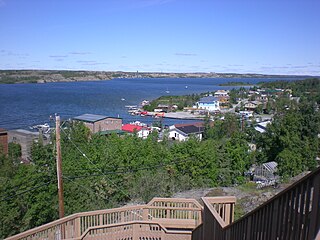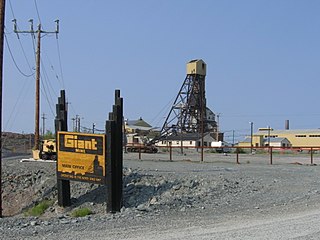Related Research Articles

Yellowknife is the capital, largest community, and only city in the Northwest Territories, Canada. It is on the northern shore of Great Slave Lake, about 400 km (250 mi) south of the Arctic Circle, on the west side of Yellowknife Bay near the outlet of the Yellowknife River.

Great Slave Lake is the second-largest lake in the Northwest Territories of Canada, the deepest lake in North America at 614 m (2,014 ft), and the tenth-largest lake in the world by area. It is 469 km (291 mi) long and 20 to 203 km wide. It covers an area of 27,200 km2 (10,500 sq mi) in the southern part of the territory. Its given volume ranges from 1,070 km3 (260 cu mi) to 1,580 km3 (380 cu mi) and up to 2,088 km3 (501 cu mi) making it the 10th or 12th largest by volume.

The Ekati Diamond Mine ("Ekati") is Canada's first surface and underground diamond mine. It is located 310 km (190 mi) north-east of Yellowknife, Northwest Territories, and about 200 km (120 mi) south of the Arctic Circle, near Lac de Gras. Until 2014 Ekati was a joint venture between Dominion Diamond Mines (80%), and the two geologists who discovered kimberlite pipes north of Lac de Gras, Chuck Fipke and Stewart Blusson each holding a 10% stake in the mine, until Fipke sold his share to Dominion.

The Giant Mine was a gold mine located on the Ingraham Trail, 5 km (3.1 mi) north of Yellowknife, Northwest Territories. Giant Mine was within the Kam Group, a part of the Yellowknife greenstone belt. Gold was discovered on the property and mineral claims staked in 1935 by Johnny Baker, but the true extent of the gold deposits was not known until 1944, when a massive gold-bearing shear zone was uncovered beneath the drift-filled Baker Creek Valley.
Royal Oak Mines Incorporated was a gold mining company, founded in 1990 by Margaret "Peggy" Witte in Kirkland, Washington.
The Ptarmigan and Tom Mine were gold producers located in the Northwest Territories, Canada at Yellowknife. The property was staked by prospectors in 1936 and acquired by Cominco in 1938. The mine first produced between 1941 and 1942 but closed due to wartime restrictions. The old property was demolished in 1969–1970. A new company, Treminco Resources Limited, reopened the workings in 1985 and production from the Tom portal began in 1986 with material being trucked to Giant Mine. The old Ptarmigan mine shaft was dewatered and production began in 1987. A new mill was built at the property and was operational in July 1989. Low gold prices forced the company to close the mines in 1997. Total gold production has been approximately 120,000 troy ounces.
Negus Mine was a gold producer at Yellowknife, Northwest Territories, Canada, from 1939 to 1952. It produced 255,807 troy ounces (7,956.5 kg) of gold from 490,808 tons of ore milled. The underground workings were acquired by adjacent Con Mine in 1953 and were used for ventilation purposes until Con Mine closed in 2003.
The Burwash Mine was a small gold property discovered in the fall of 1934 by Johnny Baker and Hugh Muir at Yellowknife Bay, Northwest Territories. The town of Yellowknife did not exist yet at that point, but the discovery of gold at Burwash was the catalyst that brought more gold prospectors into the region in 1935 and 1936. A short shaft was sunk in 1935–1936 at Burwash, and in the summer of 1935 a 16-ton bulk sample of ore was shipped to Trail, British Columbia for processing, yielding 200 troy ounces (6.2 kg) of gold. The mine did not become a substantial producer and it is believed the gold vein was mined out.
The Thompson-Lundmark Mine was a gold producer in the periods 1941–1943 and 1947–1949, near Yellowknife, Northwest Territories. Gold was discovered here in 1938 by Fred W. Thompson and Roy Lundmark, who staked 46 claims which were incorporated into the mine. Underground and shaft work began in 1939. The mine processed 133,989 tons of ore to produce 70,339 troy ounces (2,187.8 kg) of gold and 13,782 troy ounces (428.7 kg) of silver. The abandoned site was destroyed by forest fires during 1998.
The Discovery Mine was a gold mine 84 kilometers northeast of Yellowknife, Northwest Territories that operated between 1950 and 1969. Gold was discovered here by Alfred Giauque in 1944. A complete townsite, on Giauque Lake, was established by the company to house workers and their families. The mine produced one million troy ounces (31,000 kg) of gold from one million tons of ore. The abandoned townsite, not accessible by road, was demolished in 2005.
The Camlaren Mine was a small gold mine 80 km (50 mi) north-east of Yellowknife, Northwest Territories, Canada at Gordon Lake. It consists of a property totaling about 981 hectares. The two claims that make up the property were staked in 1936 by prospectors Don Cameron and the Mclaren brothers and developed with two shafts during 1937–1938. The name "Camlaren" is a portmanteau of Cameron and McLaren. Conditions attributed to World War II halted development at Camlaren in 1939.
The Outpost Island Mine was a gold and tungsten producer 94 kilometres southeast of Yellowknife, Northwest Territories on an island of Great Slave Lake. Gold was discovered here in 1935 by prospectors, and some development was undertaken in 1936–1938. Tungsten ores became valuable during World War II, so the owners investigated the tungsten possibilities of the mine. It produced small amounts of gold, copper, and tungsten during 1941–1942, and then again in 1951-1952 during the Korean War. It was a small deposit and was not considered economic because of unpredictable tungsten market prices in the 1950s.

The Ruth Mine was a small gold producer about 65 kilometres (40 mi) east of Yellowknife, Northwest Territories. It operated briefly during 1942 and resumed operations in 1959, extracting to date 550 troy ounces of gold.
The Salmita Mine was a gold producer in the Northwest Territories, Canada during 1983 to 1987. The deposit was first discovered in 1945 and underground exploration was carried out in 1951–1952. It was reactivated for exploration by Giant Yellowknife Mines Limited in 1975 and entered production in 1983. They used the old camp and milling plant of the abandoned Tundra Mine, located a few kilometres to the south. The mine produced 179,906 troy ounces (5,595.7 kg) of gold from the milling of 238,177 tons of ore. The area is now owned by Seabridge Gold.

The history of the Northwest Territories covers the period from thousands of years ago to the present day. Prior to European colonization, the lands that encompass present-day Northwest Territories were inhabited for millennia by several First Nations. European explorers and fur traders began to explore the region since the late-16th century. By the 17th century, the British laid claim to both the North-Western Territory and Rupert's Land; and granted the Hudson's Bay Company a commercial fur trade monopoly over the latter region.
Gold mining in Alaska, a state of the United States, has been a major industry and impetus for exploration and settlement since a few years after the United States acquired the territory in 1867 from the Russian Empire. Russian explorers discovered placer gold in the Kenai River in 1848, but no gold was produced. Gold mining started in 1870 from placers southeast of Juneau, Alaska.
This timeline of Yellowknife history summarises key events in the history of Yellowknife, a city in the Northwest Territories, Canada.

Gold Rush is a reality television series that airs on Discovery and its affiliates worldwide. The series follows the placer gold mining efforts of various family-run mining companies, mostly in the Klondike region of Dawson City, Yukon, Canada, as well as in the U.S. state of Alaska. In its 12th season as of early 2021, prior seasons also included mining efforts in South America and western North America.

The North Slave Métis Alliance is a non-profit society that represents the indigenous rights-bearing Métis people of the Northwest Territories, who primarily exercise their indigenous rights north and east of Great Slave Lake. The NSMA’s mandate includes: The assertion, protection, and implementation of the indigenous rights of the North Slave Métis People; and the exercise of Métis responsibility to protect the environment and to promote and enhance Métis education, economic, social, and cultural development. The NSMA is vitally concerned with the protection, preservation, and sustainable use of its traditional lands and resources. With that in mind, the NSMA is committed to principles of economic sustainability, environmental stewardship, and self-determination in respect to its traditional lands and resources.
Ranney Hill is a rock outcrop approximately 10 kilometers north of Yellowknife, the capital city of the Northwest Territories of Canada. At 682 ft / 208 m. high, it is one of three visible outcrops that can be seen north of the city. It is an anomaly rising from the relatively flat Canadian Shield.
References
- ↑ "The History of Mining in the Northwest Territories". Minerals, Oil and Gas, History of Exploration and Development. Government of the Northwest Territories: Industry, Tourism and Investment. Archived from the original on 2013-11-15. Retrieved 2013-09-27.